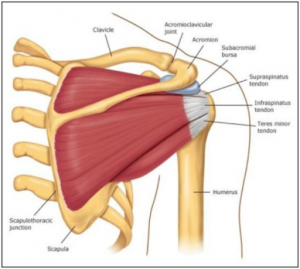Is rotator cuff degeneration the result of genetics or a consequence of overuse of the shoulder?
A medical research study offers evidence that genetics is more significant than overuse of the shoulder joint in the development of rotator cuff degeneration.[1]
The rotator cuff is a group of soft tissue muscles, ligaments and tendons that surround and encapsulate the shoulder joint. The soft tissue keeps the head of the humerus bone of the upper arm firmly within the shallow glenoid bone socket of the shoulder.[2],[3]
Pain and functional limitation due to rotator cuff degeneration is a common complaint of workers requesting medical and compensation benefits under various state and federal workers’ compensation systems. Repetitive workplace lifting, carrying and using arms overhead are decried as the cause of dysfunction of the shoulder joint and associated symptoms and disability.
The Journal of Bone and Joint Surgery recently reported the results of a shoulder magnetic resonance imaging (MRI) study on elderly twins to assess whether pathological narrowing of the subacromial space associated with rotator cuff degeneration is genetically determined or due to loading conditions. In other words, is rotator cuff degeneration a genetic condition or the result of repetitive overuse of the shoulder joint?
 The researchers identified twenty-nine pairs of elderly monozygotic (identical) and dizygotic (fraternal) twins. Each twin underwent MRI scans of both shoulders to assess the distance between the acromion (the large bony process on the scapula or shoulder bone) and humeral bone of the shoulder, as well as the health status of the rotator cuff tendons and ligaments. As reported in the Journal of Bone and Joint Surgery study, the objective MRI results and statistical assessments reveal, “the acromiohumeral distance is primarily genetically determined and is less influenced by external factors.” Accordingly, medical research indicates genetics rather than overuse is the principle cause of rotator cuff degeneration.
The researchers identified twenty-nine pairs of elderly monozygotic (identical) and dizygotic (fraternal) twins. Each twin underwent MRI scans of both shoulders to assess the distance between the acromion (the large bony process on the scapula or shoulder bone) and humeral bone of the shoulder, as well as the health status of the rotator cuff tendons and ligaments. As reported in the Journal of Bone and Joint Surgery study, the objective MRI results and statistical assessments reveal, “the acromiohumeral distance is primarily genetically determined and is less influenced by external factors.” Accordingly, medical research indicates genetics rather than overuse is the principle cause of rotator cuff degeneration.
Employers, insurers and administrators of workers’ compensation programs should make note of the genetics versus overuse study when evaluating an application for workers’ compensation benefits for conditions of the rotator cuff.
Have a question about this topic or any other workers’ compensation issue? Contact us!
[1] Gumina, S., Arceri, V., et al, “Subacromial Space Width: Does Overuse or Genetics play a greater role in Determining It?” Journal of Bone Joint Surgery America, 2015; 97:1647 (October 21, 2015).
[2] Mayo Clinic Staff, “Rotator Cuff Injury,” Mayo Clinic, (2012).
[3] “Shoulder Problems,” National Institute of Health, National Institute of Arthritis and Musculoskeletal and Skin Diseases, (April 2014).

